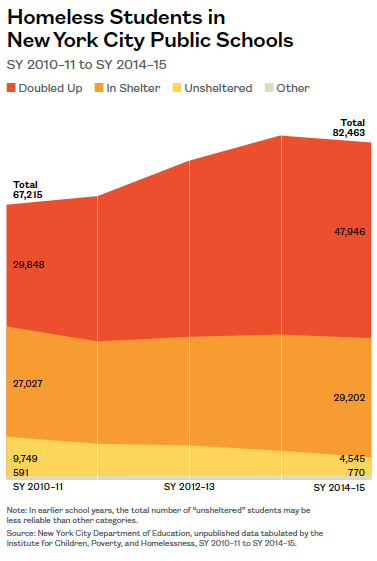In Michael Greenberg’s “Tenant’s Under Siege: Inside New York City’s Housing Crisis” he mentions that a “tide of homelessness” has swept across NYC. So much so, that shelters are being filled to maximum capacity every night. But upon doing more research it’s sadly even more severe than he leads on. According to a recent article published in the New York Times called” Homelessness in New York Public Schools Is at a Record High: 114,659 Students,” in 2018, approximately one out of ten students lived in a type of nonpermanent housing, either in a shelter or in a relatives’ home. What’s even more shocking is that if you add up this amount of homeless students, it’s even higher than the amount of people living in Albany, the state’s capital. The article also mentions that there’s a well-known school district in Bronx, District 10, where 44% of the students who go to the local high school were homeless at some point.

Taken from Institution for Children Poverty and Homelessness Website created and posted on August 17, 2016.
Video of Local News Talking About Student Homelessness
The big question is, what are the main causes of homelessness such that New York City has more homelessness now than it did during the Great Depression? One of the big culprits is unaffordable housing. In Tom Angotti’s piece “The Real Estate Capital of the World,” he mentions that of the most well-known phrases in real estate is location, location, location, the idea that where a home is situated can help cause major decreases or increases in its price (44). So the more a place gets neglected, the price of homes there decrease while places that have been receiving way more attention have their price of homes increase. However, he also mentions the concept of dislocation, that people, usually of color, lose their homes because of the area being gentrified and a rent spike occurring. This causes one of two things to occur. Either the people displaced move to a lower socioeconomic neighborhood where the cycle happens again. Or, they get displace and becomes homeless.
Angotti’s also mentions that a cause might be because of the United States’ history of slavery, racism and discrimination, and how it caused a lot of government neglect in colored neighborhoods (78). This relates to what we learned in class about Title II, in that people would get money to help pay for their mortgages from the banks, and the banks would get reimbursed if they never got their money back. A wide majority of the money (90%) went to white middle class families, neglecting people of color and these effects are still seen today.
When Angotti mentioned Walmart, it got me thinking. Would Walmart help the homelessness problem? It’s a well-known fact that despite Walmart being one of the largest corporations in the world, none are located in New York City, and it probably won’t change anytime soon. Unlike his predecessor Michael Bloomberg, Mayor Bill de Blasio is adamantly against the idea of one opening, most likely because he believes that it would cause small businesses to shut down as it would be hard to match their prices. In addition, adding a Walmart would most likely increase the price of the property surrounding it further displacing people. Even though this is true, Walmart does provide people with non-skilled employment and do have programs that help combat homelessness by providing housing assistance. So, until a Walmart opens up, it will be hard to see what will really happen.
Questions:
1. Do you think Walmart would help the homelessness problem in NYC or exacerbate it?
2. What do you think the main cause of the homelessness is dislocation due to gentrification or is there a different reason?
3. Would Robert Moses want a large corporation like Walmart to make shop in New York City or would he be against it?






